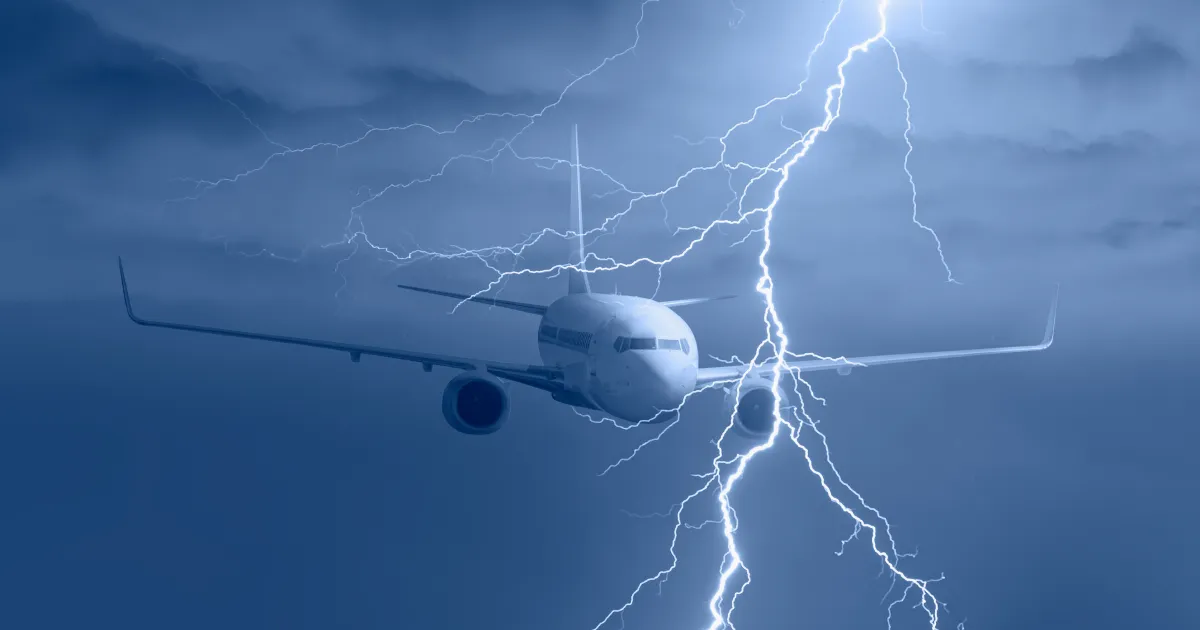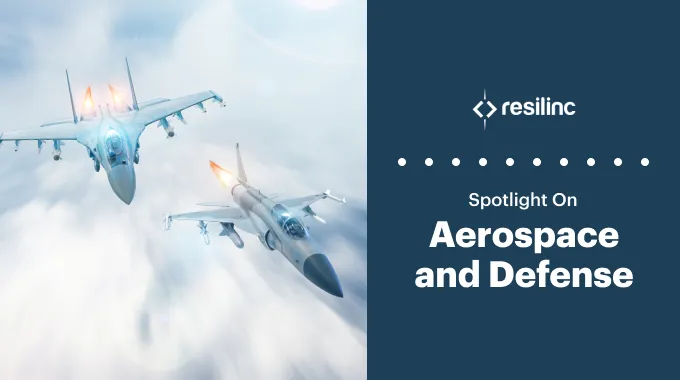The aerospace industry has recently seen increased demand for air travel, gradually returning to pre-pandemic levels. Increases in orders for new aircraft also reflect a positive turn for the industry. Despite this growth, Resilinc’s half-year data for 2023 shows that Aerospace is one of the top five industries impacted by supply chain disruptions. This exclusive data comes from EventWatchAI, Resilinc’s 24/7 AI-powered, global event monitoring platform, which collects information and monitors news on 400 different types of disruptions across 104 million global sources.
So, what are the biggest challenges the aerospace industry is facing in 2023? In this blog, we’ll dive into recent examples of each type of major supply chain disruption impacting the industry and discuss how supply chain managers can work towards more resilient supply chains and mitigate these specific risks.
#1 Factory Fires
Believe it or not, factory fires are the top disruption in aerospace so far this year—with 1250 reported. This isn’t surprising, considering factory fires have been the leading supply chain disruptions across all industries tracked by Resilinc for five consecutive years! In EventWatchAI, factory fires encompass fires and explosions at warehouses, factories, and plants, as well as investigations and force majeure due to fires.
For example, on June 26, Lithium producer Livent Corp had a fire at its largest manufacturing plant in North Carolina. A lithium compound caught fire at the 800-acre facility. Due to the water-reactive nature of lithium, no water could be applied, and the decision was made to let the impacted section of the building burn. The building that burnt down was dedicated to the production of a single product—solid lithium metal ingots—used in aerospace alloys. Following the event, Resilinc issued a supplier impact and mapped sites within a mile radius of the disruption. Resilinc suggested customers determine if suppliers were impacted, then if necessary, activate alternative sources for the solid lithium metal ingots.
In another event, on August 22, 2023, EventWatchAI sent an alert about a fire at the ARC Technologies Plant in Amesbury, England. ARC Technologies manufactures a variety of sound absorbers, including honeycomb absorbers used to reduce noise from aircraft engines. The fire started when a small piece of Styrofoam the company manufacturers caught fire in an oven. Thankfully, a worker reacted quickly and used a fire extinguisher to put out the flames. As a result, evacuated workers got back to work within only 30 minutes.
This incident is a great example of how simple safety measures (such as stocking extinguishers and training employees) can reduce the potential risk caused by factory fires. Learn how to ensure your suppliers use best practices to prevent factory fire risks in our report, Factory Fires: The Top Supply Chain Disruption.
#2 Labor Disruptions
It’s no surprise labor disruptions made the list of top disruptions in the aerospace industry. At the beginning of the year, strikes across France, Britain, and Germany caused major delays. On February 17, more than 1300 flights were canceled by Lufthansa Group in Germany due to strikes. More recently, on August 30, American Airlines flight attendants voted to authorize a strike if the company refuses to agree to updated contract terms.
On June 25, around 6,000 workers at Spirit AeroSystems went on strike in Kansas. Spirit AeroSystems manufactures aerostructures for commercial airplanes, defense platforms, and business/regional jets. The company is a lynchpin of the aerospace sector, making aerostructures for Boeing and Airbus. After a week-long strike, union workers received and accepted more favorable contracts. The company fully restarted production on July 5.
In another instance, Hulamin Aluminum Mill workers in KwaZulu-Natal, South Africa, began striking on July 14 for higher medical care contributions. Hulamin is a vital supplier of premium aluminum products for industries such as automotive, construction, electrical, shipbuilding, and aerospace. After one week of halted operations, workers reached an agreement and returned to work.
In 2023, so far this year, the aerospace industry has seen 562 labor disruptions. This can include company, site, union, and national strikes as well as layoffs, labor walkouts, protests, and more. Labor disruptions were a particular problem across all forms of global transportation as well. Learn more in our Special Report: Global Transportation Disruptions.
#3 Mergers & Acquisitions
The third-highest disruption to the aerospace industry in the first half of the year was related to mergers & acquisitions. EventWatchAI sent 541 notifications that included asset swaps, joint ventures, and share purchases for controlling stakes in this event type.
On July 13, Thales Group, a company that manufactures electrical systems, devices, and equipment for aerospace, acquired Cobham Aerospace Communications (CAC) for $1.1 billion. Headquartered in the UK, CAC produces satellite and digital radio systems that handle data and improve audio connections for major OEMS such as Gulfstream, Dassault Aviation, and Bombardier. Together, these companies plan to tap into the market of connected cockpits—which integrate data from the aircraft and ground operations, helping reduce delays and give pilots more control.
While mergers and acquisitions like this can positively affect the industry, leading to improved technologies and more resilient companies, it takes time to merge data, suppliers, and systems, which can cause challenges. Learn more about how M&As cause disruptions in our blog: How Do Mergers and Acquisitions Impact Supply Chains?
#4 Business Sale
So far in 2023, there have been over 500 business sale disruptions in aerospace. Businesses sales include the sale of factories and plants, the sale of assets and subsidiaries, and brand/portfolio sales.
For example, on August 17, US-based Ball Corporation announced the sale of its aerospace unit to BAE Systems for $5.6 billion. BAE Systems, a British company that manufactures aircraft, combat vehicles, and ammunition, aims to strengthen its position in the defense sector by acquiring Ball Aerospace. In another business sale on July 21, Collins Aerospace agreed to sell its actuation and flight controls business to Safran, a multinational aerospace and defense manufacturer of aircraft engines. The $1.8 billion deal is expected to enable Safran to become a more prominent player in the aerospace industry.
Similar to M&As, business sales can increase supply chain resilience as companies acquire new technology and expand portfolios. However, business sales can also cause increased security threats and delays while assets and information change hands.
#5 Factory Disruptions
Lastly, there were 373 factory disruptions in the aerospace industry. Factory disruptions include accidents, closures, and temporary shutdowns at warehouses, plants, and factories. There can be many reasons for factory closures—even industry growth!
Take, for example, when TE Connectivity closed a plant on August 16. The Switzerland-based company manufactures connectors and sensors across many industries, including aerospace, automotive, and medical. According to TE Connectivity, the connector and sensor division of the company experienced exponential growth in recent years, leading to a surplus of manufacturing capacity. Thus, the company needed to cut back on manufacturing.
Plants may also shut down for only a short period. From August 25 to September 9, Timken India plans to temporarily close a plant in Jharkhand, India, for the opposite reason—low demand. Timken India provides bearing products and services to aerospace, automotive, and railways. Would you be prepared for these disruptions if these companies were your suppliers? Even the most minor delays and shutdowns can cause significant issues across the supply chain. Let’s look at the steps your company can take to mitigate supply chain risk.
How Can Supply Chain Managers Mitigate Risk in the Aerospace Industry?
Supply chain disruptions for aerospace have fallen into a few major categories this year: factory fires, labor disruptions, M&As, business sales, and factory disruptions. But the first step to stay ahead of any supply chain disruption is to map your supply chain.
Did you know? 85% of disruptions originate in the indirect supply chain. These disruptions occur at factories, plants, and warehouses that you may not even be aware are part of your supply chain. By mapping your supply chain using Resilinc’s Multi-Tier Mapping, you can harness the power of sub-tier visibility to collaborate with suppliers within hours of a disruption.
After you map your supply chain, the next step is to monitor your supply chain. Learn about industry-specific disruptions like the events we pointed out by getting a 24/7 alert system. Resilinc’s EventWatchAI platform takes you from notification to mitigation in minutes. Scanning over 104 million sources and sites for potential disruptions, EventWatchAI sends tailored alerts and suggests specific actions unique to your business.
Using the powerful duo of mapping and monitoring, you can start your journey toward supply chain resiliency to avoid disruptions like these in the aerospace industry. Want to learn more about how Resilinc can help? Request a demo today.
***
For a more in-depth look at recent trends across the industry, check out our Spotlight on Aerospace and Defense. In this in-depth report, we cover recent trends fueling increased disruptions such as a 105% surge in labor disruptions across the entire A&D, new policies shaping supply chains, and solutions to mitigate your future risks.






